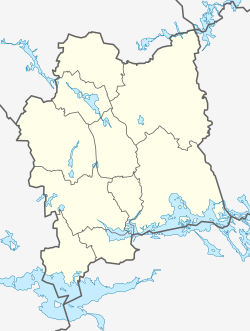Sala, Sweden
Sala | |
|---|---|
 Coat of arms | |
| Coordinates: 59°55′N 16°36′E / 59.917°N 16.600°E | |
| Country | Sweden |
| Province | Västmanland |
| County | Västmanland County |
| Municipality | Sala Municipality |
| City status | 1624 |
| Area | |
| • Total | 11.01 km2 (4.25 sq mi) |
| Population (31 December 2010)[1] | |
| • Total | 12,289 |
| • Density | 1,116/km2 (2,890/sq mi) |
| Time zone | UTC+1 (CET) |
| • Summer (DST) | UTC+2 (CEST) |
| Website | www.sala.se |
Sala is a locality and the seat of Sala Municipality in Västmanland County, Sweden, with 12,289 inhabitants in 2010.[1]
It is the home of several famous places and people, for instance "Sala-ligan". Sala is most known for its silver mine, which today is a popular tourist attraction.
Silvergruva

The small town is best known for its historic silver mine (silvergruva), which is located about 1.7 miles southwest of the town. It dates back to at least Medieval times, and was in operation until 1908. In 1624, the town of Sala was moved to its current location close to the mine, receiving its royal charter from King Gustavus Adolphus.[2]
The silver was important for Sweden's economy and the base for coin production. A total of 400 tonnes of silver was extracted, and 40,000 tonnes of lead; with at most 3-5 tonnes of silver during a year.
The mine eventually reached a depth of 300 metres, and a total heading length of 20 kilometres. It is today a popular attraction.
Amenities

The main street, in terms of retail outlets, is Drottninggatan, to the west of Stora Torget (the town square), and Bergmansgatan, to the east.

The spa town of Sätra brunn, about nine miles from Sala, is another important place for the town.
Sport
The first floorball club in the world, Sala IBK, was founded in Sala 1979.[3]
Notable people
The impressionist painter Ivan Aguéli was born in Sala in 1869. There is a small museum and a park dedicated to his memory in the centre of the town. Sala is also the domicile of the former Swedish Minister of Foreign Affairs and former Deputy Prime Minister Lena Hjelm-Wallén. She held several ministerial posts in the Social Democratic government in the 1980s and 1990s and has, despite her career in politics, remained in Sala and is still active in local life.
Hockey player Erik Ersberg was born here.
References
- ^ a b c "Tätorternas landareal, folkmängd och invånare per km2 2005 och 2010" (in Swedish). Statistics Sweden. 14 December 2011. Archived from the original on 10 January 2012. Retrieved 10 January 2012.
{{cite web}}: Unknown parameter|deadurl=ignored (|url-status=suggested) (help) - ^ "Silver town Sala". sala.se Tourist information. Sala municipality. Retrieved 11 September 2015.
- ^ Innebandyns födelse
External links
![]() Media related to Sala, Sweden at Wikimedia Commons
Media related to Sala, Sweden at Wikimedia Commons


